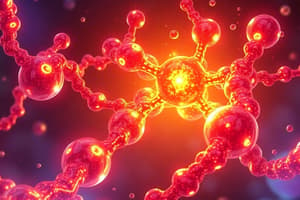Podcast
Questions and Answers
What is the equilibrium constant, Keq, defined as?
What is the equilibrium constant, Keq, defined as?
Keq = [H+][OH-]/[H2O]
What is the equilibrium constant, Keq, of water under standard conditions?
What is the equilibrium constant, Keq, of water under standard conditions?
In pure water, the concentration of protons ([H+]) is equal to the concentration of hydroxide ions ([OH-]).
In pure water, the concentration of protons ([H+]) is equal to the concentration of hydroxide ions ([OH-]).
True (A)
What is the pH of a solution with a [H+] concentration of 10^-2 M?
What is the pH of a solution with a [H+] concentration of 10^-2 M?
Signup and view all the answers
What is the pH of a solution with a [OH-] concentration of 10^-2 M?
What is the pH of a solution with a [OH-] concentration of 10^-2 M?
Signup and view all the answers
What is biochemistry?
What is biochemistry?
Signup and view all the answers
Which six non-metallic elements constitute more than 97% of the weight of living organisms?
Which six non-metallic elements constitute more than 97% of the weight of living organisms?
Signup and view all the answers
Water is the most indispensable nutrient for humans.
Water is the most indispensable nutrient for humans.
Signup and view all the answers
Macromolecules are polymers created by joining smaller organic molecules, referred to as ________, via condensation reactions.
Macromolecules are polymers created by joining smaller organic molecules, referred to as ________, via condensation reactions.
Signup and view all the answers
What is the main characteristic underlying the properties of water?
What is the main characteristic underlying the properties of water?
Signup and view all the answers
What is the angle between the two covalent O-H bonds in water?
What is the angle between the two covalent O-H bonds in water?
Signup and view all the answers
What type of bond is formed between the slightly positive hydrogen atom of one molecule and the slightly negative oxygen atom of another molecule?
What type of bond is formed between the slightly positive hydrogen atom of one molecule and the slightly negative oxygen atom of another molecule?
Signup and view all the answers
What is the heat energy required to disrupt a hydrogen bond in water?
What is the heat energy required to disrupt a hydrogen bond in water?
Signup and view all the answers
Which type of molecules are hydrophobic and do not dissolve in water?
Which type of molecules are hydrophobic and do not dissolve in water?
Signup and view all the answers
Water is the only molecule capable of establishing hydrogen bonds.
Water is the only molecule capable of establishing hydrogen bonds.
Signup and view all the answers
Study Notes
Introduction to Biochemistry
- Biochemistry is the study of the molecules and biochemical reactions of life.
- It explores the molecular mechanisms that underlie the functioning of living organisms.
Importance of Water
- Water is the most indispensable nutrient, and humans can survive only a few days without it.
- Life is a water-based phenomenon, and water constitutes 60-70% of the mass of cells.
- Water is an excellent solvent, and macromolecules are subdivided according to their water affinity (hydrophilic versus hydrophobic).
Functions of Water
- Transports nutrients and oxygen
- Regulates cell structure
- Aids in regulating the body temperature
- Serves as a shock absorbent
- Serves as a solvent
- Cleanses the blood of waste
Structure of Water
- Water is a polar molecule, with a V-shaped structure and a 104.5o angle between the two covalent O-H bonds.
- Oxygen has 8 electrons, 2 in the inner shell and 6 in the outer shell, which can accommodate 8 electrons in one s and three p orbitals.
- The outer shell electrons occupy 4 sp3 hybrid orbitals, which are pictured as occupying the four corners of a tetrahedron.
Hydrogen Bonding
- Hydrogen bonds are a type of non-covalent attraction between the slightly positive hydrogen atom of one molecule and the slightly negative oxygen atom of another molecule.
- The water molecule contributing the hydrogen is called the hydrogen donor, and the molecule contributing the electronegative atom is called the hydrogen acceptor.
- Hydrogen bonds are weaker than covalent bonds, but are crucial for the structure and function of macromolecules.
Properties of Water
- High melting point of ice due to hydrogen bonding
- Lower density of solid phase compared to liquid phase
- High specific heat/heat capacity
- High heat of vaporization
Non-covalent Interactions
- Hydrogen bonds: between hydrogen donor and hydrogen acceptor
- Charge-charge interactions: electrostatic interactions between two charged molecules
- Van der Waals forces: weak non-covalent interactions between permanent dipoles of two uncharged polarized bonds
- Hydrophobic interactions: the exclusion of non-polar molecules from water, leading to their association with each other
Ionization of Water
- Water can ionize into hydronium (H3O+) and hydroxide (OH-) ions
- The ionization of water is a reversible reaction, and the concentrations of reactants and products reach equilibrium
- The ion product for water (Kw) is 1x10-14 M2
pH and pOH
- pH is a logarithmic scale that measures the concentration of protons in a solution
- pH = -log[H+] = log 1/[H+]
- pOH is a logarithmic scale that measures the concentration of hydroxide ions in a solution
- pOH = -log[OH-] = log 1/[OH-]
Studying That Suits You
Use AI to generate personalized quizzes and flashcards to suit your learning preferences.
Description
This quiz covers the basics of biochemistry, including the definition and importance of biochemistry, the composition of living organisms, and the functions of water in biological systems.





